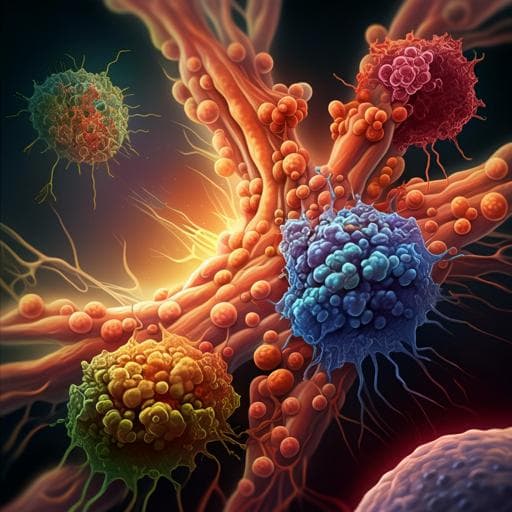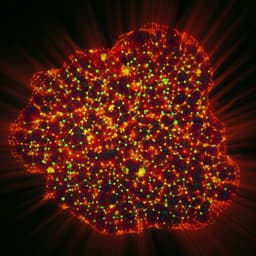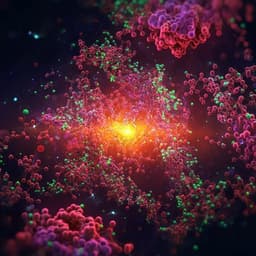
Medicine and Health
Single-cell and spatial transcriptome analyses reveal tertiary lymphoid structures linked to tumour progression and immunotherapy response in nasopharyngeal carcinoma
Y. Liu, S. Ye, et al.
This pioneering research by Yang Liu and colleagues reveals the intricate relationship between tertiary lymphoid structures and nasopharyngeal carcinoma. By analyzing a staggering 343,829 single-cell transcriptomes, they uncover key immune cell populations and their roles in enhancing the immunotherapy response and patient prognosis. Dive into the exciting findings that could redefine cancer treatment strategies!
~3 min • Beginner • English
Introduction
The study investigates how tertiary lymphoid structures (TLSs) form, are composed, and function within the tumour microenvironment (TME) of nasopharyngeal carcinoma (NPC), and how they interact with tumour cell aggregates (TCAs). TLSs are structured immune cell niches associated with improved antitumour immunity and clinical outcomes, yet their precise cellular constituents, formation drivers, and spatial interactions with tumour cells in human cancers remain incompletely defined. The authors aim to delineate TLS components at single-cell and spatial resolution, chart B cell germinal centre (GC) dynamics and developmental trajectories, identify stromal drivers of TLS (e.g., specific CAF subsets), characterise TLS–tumour spatial crosstalk including EBV-associated contexts, and evaluate the prognostic and immunotherapy predictive value of TLS-related signatures in NPC.
Literature Review
Prior work has shown TLSs contain T and B cell zones, APCs, T follicular helper cells, and follicular dendritic cells, with single-cell and spatial studies identifying TLS-associated populations across cancers (e.g., CXCL13+ helper T cells in ovarian cancer, SEMA4A+ GC B in head and neck cancer, CXCL12+ fibroblasts in renal cell cancer). GC reactions within TLSs drive B cell clonal selection, affinity maturation, and plasma cell generation, but dynamic trajectories in tumours remain underexplored. TLS neogenesis has been linked to LTi cells, FRCs, FDCs, chemokines (CXCL13, CCL17, CCL21), adhesion molecules (VCAM1, ICAM1), and LTBR signalling in non-malignant contexts, with stromal/endothelial orchestration of TLS formation in mouse tumour models. TLS presence correlates with immune infiltration, favourable survival, and better ICB responses in several cancers. However, the key human tumour components driving TLS formation and the spatial mechanisms by which TLS-derived effector cells engage malignant cells have not been fully defined, particularly in EBV-associated cancers like NPC.
Methodology
- Samples and cohorts: scRNA-seq and VDJ-seq from 77 samples (56 NPC tumours, 11 non-cancerous nasopharyngeal tissues, 10 PBMC) yielding 343,829 cells after QC. Spatial transcriptomics (ST): Stereo-seq on 3 fresh-frozen NPC tumours (9563 bins, each covering 10,000 spots) and 10x Visium on 12 FFPE NPC tumours (21,753 spots), plus Visium on 2 fresh-frozen EBV gastric cancers. Independent cohorts included a microdissection RNA-seq dataset (n=189 regions), a Bulk-RNA-seq NPC cohort (n=147), and a Microarray NPC cohort (n=150). An FFPE Visium cohort of 12 advanced NPC patients had clinical response data to PD-1 blockade (toripalimab) plus chemotherapy.
- Single-cell processing: Cell Ranger (v3.0.1) for count and VDJ; mapped to GRCh38 and EBV Akata. QC removed doublets (DoubletFinder), low-UMI/cell/gene and high-mito cells. Batch integration via Harmony; clustering and subclustering with Seurat; major cell types annotated by canonical markers. InferCNV distinguished malignant epithelial cells. BCR/TCR repertoire analysed with Change-O/IgBLAST/STARTRAC (clonotypes, SHM, isotype switch, transitions, diversity).
- Spatial data: Space Ranger for Visium; SAW pipeline for Stereo-seq; normalization with SCTransform; sub-spot enhancement with BayesSpace; spatial region definitions (TLS, TCA, stroma) using pathologist review and gene signatures. EBV status inferred by EBV genes (Stereo-seq, fresh-frozen Visium GaC) or an EBV-high vs low DEGs signature (FFPE Visium NPC). Module scores (AddModuleScore) used for cell-type and functional signatures.
- Trajectory and pathway analyses: Diffusion map pseudotime for B cells; GC dark/light zone continuum via PCA and predefined signatures; Monocle3 for CD8+ T cell trajectories; GSVA/GSEA for pathway enrichment; apoptosis, activation, exhaustion, stem-like, immunosuppressive module scores defined by curated gene sets.
- Cell–cell communication: CellChat to infer ligand–receptor interactions among cell types; CSOmap to model CD8+ T–malignant interactions; SpaGene to map spatial ligand–receptor connectivity in ST.
- Experimental validation: Multiplex IHC/IF (7-plex) to visualise TLS composition and spatial proximities (e.g., CASP3+PanCK+ tumour cells near IgG+ plasma cells, CXCL13+CD8+PD1+HAVCR2− T cells). In situ hybridization for EBERs to confirm EBV in malignant cells. In vitro co-culture assays using CAFs and human B cells: adhesion (VCAM1/ICAM1), migration (CXCL13/CXCR5 axis), and IgG production (TNFSF13B/BAFF signalling), including neutralising/overexpression perturbations. Statistical analyses included t-tests, Wilcoxon/Kruskal–Wallis, Pearson correlations, and Cox models (KM and multivariate).
Key Findings
- Cellular and spatial composition of TLS in NPC: scRNA-seq identified major TLS-associated populations: B lineage (Naïve, Memory, GC, Plasma), Tfh-like CD4_C8_CXCR5, stem-like CD8_C8_CXCL13 T cells, and a TLS-associated CXCL13+ CAF subset (iCAF_C2_CXCL13). ST (Stereo-seq and Visium) corroborated their co-localization in TLS regions.
- B cell GC reactions and tumour progression:
- BCR profiling (n=19,405 B cells with clonotypes) showed higher SHM, clonality, and IGHA/IGHG isotypes in tumour vs PBMC. Pseudotime traced Naïve→Memory/GC→Plasma trajectory with increasing SHM, clonal expansion, and class switch. GC B cells spanned dark–light zone states with AICDA (DZ) and CD83 (LZ) expression.
- GC B cell proportion was lower in advanced-stage NPC (median 1.0%) vs early-stage (median 3.3%). Transitions of shared BCR clonotypes from GC B to plasma cells decreased in advanced tumours. Plasma cell pan-Ig transcription and IgA/IgG protein levels were lower in advanced-stage across cohorts; plasma cells from advanced-stage tumours downregulated BCR signalling, protein biosynthesis/transport pathways, suggesting reduced antibody production.
- Plasma cells in TLS exhibited higher antibody-production signatures than those in TCA. Higher GC B proportions and pan-Ig levels associated with better prognosis (Bulk-RNA-seq PFS: HR=0.39, P=0.019; Microarray PFS: HR=0.33, P=0.00095; OS: HR=0.19, P=0.00012).
- Antibody-mediated tumour apoptosis and EBV context:
- Plasma cells colocalised with NK cells and macrophages; their proportions were positively correlated in most ST samples, consistent with ADCC/ADCP mechanisms.
- Defined TCA subtypes by EBV status and plasma presence: EBVhigh/low with plasma (TCA-WP) or without (TCA-woP). EBVlow-TCA was negatively associated with high plasma cell proportions. TCA with plasma, especially EBVhigh-TCA-WP, showed higher apoptosis signatures (e.g., FAS, CASP3) than those without; confirmed by multiplex IHC showing more CASP3+PanCK+ tumour cells near IgG+ plasma cells in EBVhigh-TCA and by spatial proximity analyses. Similar patterns observed in EBV gastric cancer ST and an NPC microdissection cohort.
- Malignant NPC cells (EBV/LMP1+) potentially attract plasma cells via CCL2–CCR2; plasma cell signatures correlated with CCL2–CCR2 expression in bulk RNA-seq.
- Plasma cells and immunotherapy response:
- In the Visium FFPE NPC ICB cohort (n=12), responders had higher tumoral pan-Ig expression, more plasma-infiltrated TCA (notably EBVhigh-TCA-WP), and higher apoptosis signatures than non-responders. EBVhigh malignant cells and non-responders showed higher immunosuppressive signatures.
- CXCL13+ CAFs orchestrate B cell recruitment/adhesion and antibody production:
- Identified iCAF_C2_CXCL13 expressing CXCL13, CCL19, CCL21, VCAM1, ICAM1, complement C2/C3, and TNFSF13B; GSVA enriched for B cell chemotaxis, GC formation, complement activation. Their proportions decreased from early to advanced stages and correlated with B lineage and IgH expression across cohorts. Spatially localised within TLS and plasma aggregates.
- CellChat/SpaGene revealed strong CXCL13–CXCR5, VCAM1/ICAM1–integrins, and TNFSF13B–TNFRSF13B/17/13C interactions with B/plasma cells in TLS regions. Co-cultures: VCAM1+ CAFs increased B cell adhesion (abolished by anti-VCAM1), CXCL13 overexpression enhanced B cell migration (blocked by anti-CXCL13), and VCAM1+ CAFs boosted IgG production; TNFSF13B overexpression in fibroblasts increased B cell IgG production, reversed by TNFSF13B neutralisation. Higher CXCL13+ CAF proportion combined with higher IgG associated with better prognosis.
- CD8_C8_CXCL13 stem-like T cells in TLS give rise to exhausted CD8_C11_HAVCR2 in TCA:
- CD8_C8_CXCL13 expressed activation (CD27, CD28, ICOS, TNFRSF4/14), stem-like (TCF7, BCL6, PLAGL1), chemokines (CXCL13, CXCR5/CXCR3/CCR4), and TLRs; PDCD1 present without other exhaustion markers. PDCD1 correlated with activation genes in CD8_C8_CXCL13 but with exhaustion genes in CD8_C11_HAVCR2. GSVA indicated distinct epigenetic/metabolic programmes.
- Monocle3 trajectories showed paths from CD8_C8_CXCL13 (and other precursors) to terminal CD8_C11_HAVCR2 with increasing exhaustion and decreasing stemness; top TCR clonotype sharing was strongest between these two clusters; TCR diversity decreased in CD8_C11_HAVCR2. Spatially, CD8_C8_CXCL13 enriched in TLS, while CD8_C11_HAVCR2 enriched in TCA.
- CSOmap predicted stronger malignant interactions with CD8_C8_CXCL13 than with exhausted cells, including chemokine and co-stimulatory connections (e.g., CD27–CD70); IHC confirmed CD70+ tumour proximity to CD27+ CXCL13+ CD8 T cells. CD8_C8_CXCL13 prevalence was low (0–~11%) but higher in early-stage NPC.
- Prognostic and predictive value of TLS components:
- Across multiple cohorts, higher proportions/signatures of seven TLS-associated cell types (Naïve B, Memory B, GC B, Plasma, CD4_C8_CXCR5, CD8_C8_CXCL13, iCAF_C2_CXCL13) associated with improved PFS/OS. A composite TLS cell signature (TLS-CS) stratified patients into high vs low groups with significantly better outcomes for TLS-CS high (Bulk-RNA-seq PFS: HR=0.29, P=0.0018; Microarray PFS: HR=0.32, P=0.00033; OS: HR=0.19, P=0.00002). These components/signatures were also higher in ICB responders.
Discussion
This work delineates the cellular constituents, developmental programs, and spatial crosstalk of TLSs and tumour cell aggregates in NPC, addressing how TLS-derived B and T cells interface with malignant cells and influence clinical outcomes. The data show that GC reactions within TLSs generate antibody-secreting plasma cells that disperse into TCAs and, together with NK cells/macrophages, are associated with apoptosis of EBVhigh malignant cells—linking humoral responses to tumour control and ICB responsiveness. The identification of CXCL13+ CAFs as TLS-associated stromal organisers that recruit, adhere, and mature B cells via chemokines, adhesion molecules, complement, and BAFF signalling provides a stromal mechanism for human TLS formation and function. On the T cell axis, stem-like CXCL13+ CD8+ T cells reside in TLS, interact with B cells, and differentiate toward exhausted CD8+ T cells enriched in TCAs, suggesting TLSs as reservoirs of tumour-reactive precursors that can be leveraged therapeutically. Collectively, TLS-related cell signatures robustly stratify prognosis and predict response to PD-1 blockade, underscoring their clinical relevance.
Conclusion
The study maps TLS composition and function in NPC at single-cell and spatial resolution, uncovering key components (CXCL13+ CAFs, GC B cells, plasma cells, CD4+ Tfh, stem-like CXCL13+ CD8+ T cells) and their interactions with tumour regions. GC reactions in TLS sustain plasma-cell–mediated antibody production that associates with EBVhigh tumour cell apoptosis and ICB response. CXCL13+ CAFs mechanistically promote B cell recruitment, adhesion, and IgG production via CXCL13–CXCR5, VCAM1/ICAM1–integrins, and TNFSF13B signalling. Stem-like CD8_C8_CXCL13 T cells in TLS develop toward exhausted CD8+ T cells within TCAs and maintain tumour reactivity. TLS-derived cell signatures predict survival and immunotherapy response, offering biomarkers and mechanistic insights. Potential future directions include: expanding cohorts for validation; elucidating molecular drivers of TLS formation in human tumours; therapeutically inducing or augmenting CXCL13+ CAF and TLS activity; combining EBV-specific antibodies with PD-1 blockade in EBV-associated cancers; and strategies to enrich or engineer CXCL13+ stem-like CD8+ T cells for adoptive cell therapy.
Limitations
- Mechanistic depth: While CXCL13+ CAFs and their ligand–receptor networks are implicated in TLS formation and B cell function, the upstream molecular drivers and full differentiation pathways require further characterisation.
- Cohort size for immunotherapy analyses: The FFPE Visium ICB cohort (n=12) is small; larger, independent cohorts are needed to confirm predictive value and clinical utility of TLS-related signatures.
- EBV measurement constraints: 10x Visium FFPE lacks EBV probes; EBV status in FFPE was inferred via a surrogate gene signature. Although validated with Stereo-seq EBV reads and EBER ISH, misclassification risk remains.
- Technical biases: Microfluidic scRNA-seq may capture fewer tumour cells relative to immune/stromal cells; potential cell-type–specific capture biases could affect proportions. Spatial resolution differences between platforms and binning strategies could influence deconvolution and spatial assignment.
- Generalisability: Findings are based on NPC and EBV-related contexts; applicability to other tumour types and virus-negative settings needs further study.
Related Publications
Explore these studies to deepen your understanding of the subject.







